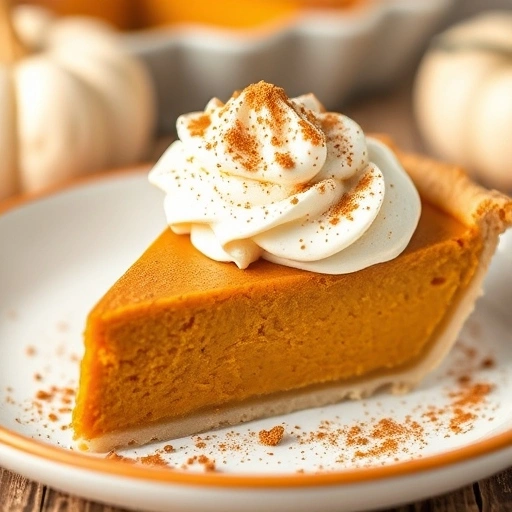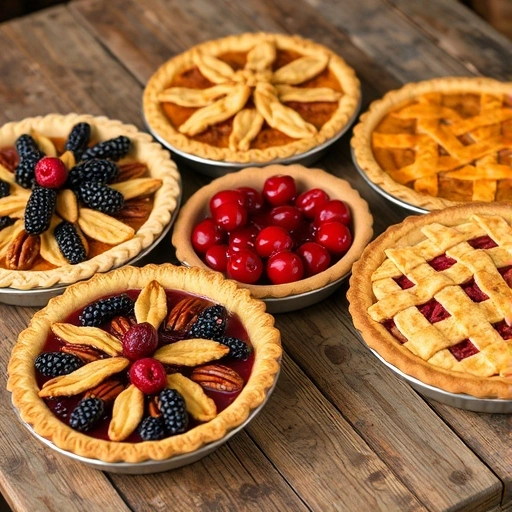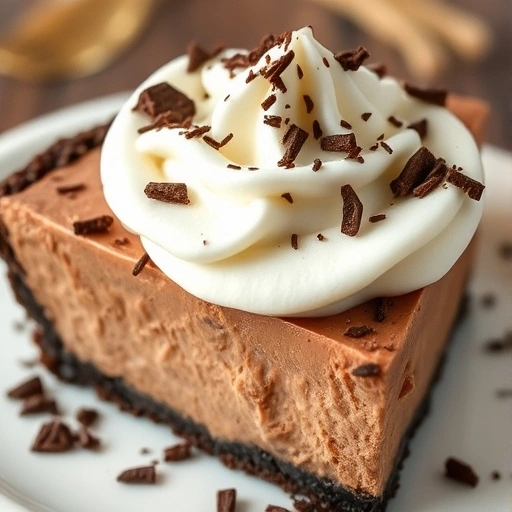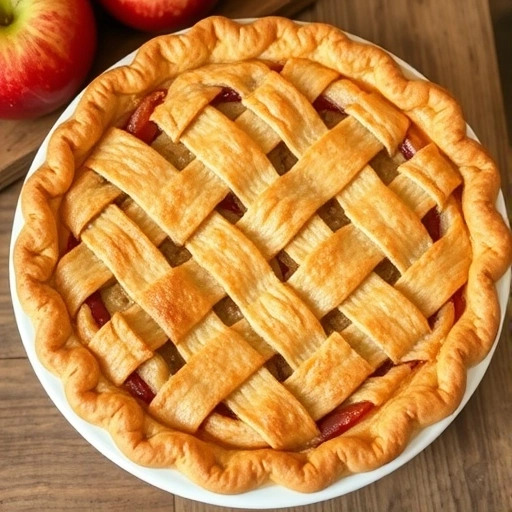American pies are a beloved staple of traditional home baking, cherished for their comforting flavors, flaky crusts, and versatile filling options. From sweet fruit-filled pies to rich, indulgent cream pies, American pies have a rich history that dates back to colonial times. Over the years, these pies have evolved, incorporating a wide variety of ingredients and regional twists, making them a cherished part of family gatherings, holidays, and everyday desserts. Whether you’re a novice baker or a seasoned pie enthusiast, mastering the art of the perfect American pie opens the door to endless possibilities for delicious flavors and satisfying creations.
Choosing the Right Pie Crust
Types of Pie Crust
Pie crust is one of the most important components of a delicious American pie. The right crust can make or break the overall taste and texture. Below are the three main types of pie crust, each offering unique qualities for various pie styles:
1. Flaky Pie Crust
Flaky pie crust is the most traditional and widely used. It’s known for its light, buttery, and delicate layers that create a crispy yet tender texture. This type of crust is ideal for fruit pies, cream pies, and many other sweet or savory varieties. Achieving a flaky crust involves using cold butter or shortening, handling the dough minimally, and keeping the fat separate from the flour, which creates layers during baking.
2. Shortcrust Pastry
Shortcrust pastry is slightly denser and richer than flaky crust, offering a more crumbly and buttery texture. It works well for pies that need a firmer base, such as savory pies or custard-filled tarts. This crust is easy to handle, making it perfect for intricate designs and deep-dish pies. Shortcrust also holds fillings better due to its sturdier structure.
3. Graham Cracker Crust
A graham cracker crust is a no-bake or baked option primarily used for pies like key lime pie, cheesecake, or chocolate desserts. Made from crushed graham crackers, sugar, and melted butter, this crust provides a sweet, crunchy base with a more crumbly texture. It’s often used for pies that don’t require a traditional pastry crust but still offer a satisfying and flavorful foundation.
Each type of crust enhances the flavors and textures of the filling, giving bakers the flexibility to create a variety of pie experiences.

Making a Perfect Crust
Creating the perfect pie crust is essential for a well-balanced and delicious pie. A great crust should be flaky, tender, and golden, with just the right balance of flavor and texture. Whether you’re using a traditional flaky crust, shortcrust pastry, or graham cracker crust, there are key techniques to ensure success. Below are essential steps to making a perfect crust:
1. Chilling Ingredients
One of the most important steps in making a perfect crust is ensuring that all your ingredients are cold. Cold butter or shortening helps create a flaky texture because it prevents the fat from melting too quickly during mixing or baking. If the fat stays cold, the layers within the crust remain intact, resulting in a light and flaky texture.
2. Handling the Dough Gently
Overworking the dough can lead to a tough crust. When mixing the ingredients, it’s important to handle the dough lightly and avoid over-kneading or pressing it too much. Light, gentle handling helps maintain the desired flakiness.
3. Proper Mixing Techniques
When incorporating butter or shortening into the flour, you can either use a pastry cutter, fork, or food processor. The goal is to create pea-sized pieces of fat within the flour, which will create pockets for steam to form, resulting in a flaky crust.
4. Resting the Dough
After forming the dough, letting it rest in the refrigerator for at least 30 minutes helps the gluten relax and the fat chill further. Chilled dough is easier to roll out and less prone to shrinking during baking.
5. Blind Baking for Flaky Results
Blind baking, or pre-baking the crust, is essential for fillings that release moisture, like fruit pies or custards. This step ensures the crust doesn’t become soggy and holds its shape beautifully.
By following these steps, you can achieve a perfect crust that complements a wide variety of fillings, making your pie both visually appealing and delicious.
Popular Pie Fillings
Apple Pie
Apple pie is a classic American dessert that has been enjoyed for generations. With its comforting flavors, flaky crust, and perfectly spiced filling, it remains a staple at family gatherings, holidays, and special occasions. Whether you prefer a traditional apple pie or enjoy experimenting with different variations, mastering the art of apple pie is a rewarding experience. Below, we delve into the essential elements that make a great apple pie.
1. Types of Apples for Apple Pie
The type of apple used significantly impacts the flavor and texture of the pie. Some apples are better suited for baking because they hold their shape well and provide a balance between sweetness and tartness. Here are some popular choices:
Granny Smith: Offers a tart, firm texture and bright flavor.
Honeycrisp: Combines a sweet and crisp texture, perfect for balance.
Braeburn: Slightly tangy with a firm structure, ideal for holding up in pies.
Fuji: Sweeter apples with a tender texture, suitable for sweeter apple pies.
2. Apple Pie Filling
For a perfect apple pie filling, it’s important to balance flavors and achieve the right consistency. A good filling should have a mix of sweetness, acidity, and warmth from spices like cinnamon, nutmeg, and allspice. You can also add a touch of lemon juice or zest to enhance the apples’ natural flavor. Additionally, some prefer to use thickening agents like cornstarch or flour to create a smooth filling without excess juice.
3. Enhancing Apple Pie
Caramel Apple Pie: For a rich, indulgent twist, consider adding a layer of caramel sauce or incorporating brown sugar into the filling.
Almond Extract: Adding a hint of almond extract can elevate the flavor profile and provide a unique depth to the pie.
Oat Topping: For a heartier, rustic apple pie, adding an oatmeal topping creates a crunchy texture that pairs beautifully with the sweet filling.
4. Pie Crust for Apple Pie
A flaky, buttery crust is essential to complement the spiced apple filling. You can use a traditional flaky crust or opt for a shortcrust pastry for a more substantial texture. Pre-baking or blind baking the crust ensures a crisp base, which holds up well against the moist apple filling.
Apple pie offers endless opportunities for creativity, whether you prefer a traditional lattice crust or a modern twist with streusel toppings. Perfecting this dessert allows you to create a timeless treat enjoyed by all!
Pumpkin Pie
Pumpkin pie is a quintessential holiday dessert enjoyed across the United States, particularly during Thanksgiving and autumn celebrations. Its rich, spiced filling and flaky crust create a comforting, warm dessert that pairs perfectly with a dollop of whipped cream. Whether you’re making a traditional pumpkin pie or adding unique twists, mastering this beloved pie is a rewarding culinary experience.
1. Pumpkin Filling
The filling for pumpkin pie is made primarily from pureed pumpkin, spices, eggs, cream or milk, and sweeteners. The key to a smooth and flavorful filling lies in selecting the right type of pumpkin. While fresh pumpkin can be used, many bakers opt for canned pumpkin puree for convenience and consistent results. When making homemade pumpkin puree, choose a sugar pumpkin or a similar variety known for its sweetness and richness.
Spices like cinnamon, nutmeg, ginger, and cloves bring warmth and depth to the filling. For a more complex flavor, adding a hint of allspice or cardamom can elevate the pie.
2. Perfect Pumpkin Pie Spice Blend
To achieve a balanced flavor, creating a custom spice blend is ideal. Common combinations include:
1 teaspoon cinnamon
½ teaspoon nutmeg
¼ teaspoon ginger
¼ teaspoon cloves
Optional: a pinch of allspice or cardamom
This blend should complement the natural sweetness of the pumpkin and create a well-rounded flavor.
3. Creamy and Velvety Texture
For a smooth, creamy texture in your pumpkin pie, it’s essential to avoid overmixing the filling, which can incorporate too much air and lead to cracks during baking. Use a gentle hand to combine the ingredients and ensure a uniform consistency.
4. Crust for Pumpkin Pie
Pumpkin pie pairs best with a flaky, buttery crust that supports the rich filling without overpowering it. A classic all-butter crust or a combination of butter and shortening provides a light, crispy base. Blind baking the crust beforehand ensures it remains crisp, even with the moist pumpkin filling.
5. Serving and Garnishes
Pumpkin pie is traditionally served chilled or at room temperature, topped with a generous dollop of whipped cream or a drizzle of caramel sauce. For an elevated presentation, consider adding toasted pecans or a dusting of cinnamon on top for a festive touch.
With its rich flavor and warm spices, pumpkin pie remains a beloved dessert that captures the essence of fall and holiday celebrations.
Enhancing Pie Flavor
Cherry Pie
Cherry pie is a timeless dessert that combines the tartness of fresh or canned cherries with a sweet, buttery crust. Whether made with sweet, ripe cherries or tart pie cherries, this pie offers a refreshing and satisfying balance of flavors. Perfect for summer gatherings or holiday feasts, cherry pie is beloved for its vibrant red color, juicy filling, and flaky crust. Below, we explore the essential elements that contribute to a delicious cherry pie.
1. Types of Cherries for Cherry Pie
The type of cherries used plays a significant role in the flavor and texture of the pie. There are two main varieties used for cherry pie:
Sweet Cherries: Such as Bing or Rainier, offer a sweeter flavor and tender texture, ideal for a dessert pie.
Tart Cherries: Like Montmorency or Morello, provide a tangy and slightly sour flavor, which pairs beautifully with the sugar and spices in the filling.
Mixing both sweet and tart cherries is a popular approach to achieving the perfect balance of sweetness and acidity.
2. Cherry Pie Filling
The filling for cherry pie is typically made by combining pitted cherries with sugar, cornstarch or flour (to thicken the filling), and a blend of spices like cinnamon, nutmeg, and almond extract for depth. Fresh lemon juice or zest is also added to enhance the natural cherry flavor and provide a bright, zesty note.
For a rich, glossy filling, cherry juice or a combination of cherry juice and cherry liqueur can be incorporated for extra flavor and moisture control.
3. Prepping the Cherries
To ensure even cooking and prevent a watery filling, it’s important to prep the cherries properly. Washing, pitting, and drying the cherries before use will prevent excess moisture from diluting the filling. You can also freeze the cherries before baking to maintain their shape and retain some juiciness during the baking process.
4. Thickening the Filling
Cornstarch is a popular thickening agent for cherry pie filling as it creates a smooth, firm consistency. If using fresh cherries, it’s often necessary to cook the filling briefly before assembling the pie to ensure it reaches the right thickness and prevents a runny filling.
5. Crust for Cherry Pie
A flaky, buttery crust is essential for cherry pie to contrast with the juicy filling. Whether you use a traditional flaky crust or a lattice crust design, the crust should be golden brown and crisp. Blind baking the bottom crust before adding the filling helps prevent a soggy base, especially if the cherries release a lot of juice during baking.
6. Serving and Variations
Cherry pie is traditionally served warm or at room temperature, often topped with a scoop of vanilla ice cream or a dollop of whipped cream. For added indulgence, consider adding a streusel topping or experimenting with different crust designs, such as braided edges or decorative cutouts.
Cherry pie remains a beloved dessert, offering a perfect balance of sweetness, tartness, and texture that never goes out of style.
Blueberry Pie
Blueberry pie is a classic, refreshing dessert known for its sweet, tangy, and juicy filling paired with a flaky, golden crust. Whether made with fresh, frozen, or a combination of blueberries, this pie captures the essence of summer and the flavors of ripe, seasonal berries. With its vibrant purple-blue filling and subtle spices, blueberry pie remains a favorite for both casual gatherings and special occasions.
1. Types of Blueberries for Blueberry Pie
The type of blueberries used in a pie can impact both flavor and texture. While fresh blueberries are ideal, especially during peak harvest season, frozen blueberries can also deliver great results. Here are a few key choices:
Fresh Blueberries: Offer the most vibrant color and fresh flavor, ideal for pies with a balanced taste.
Frozen Blueberries: Convenient and available year-round, they often retain their juiciness and can be thawed before use for best results.
Wild Blueberries: Smaller and more intense in flavor, wild blueberries provide a stronger, more concentrated berry taste.
2. Blueberry Pie Filling
The filling for blueberry pie is simple yet flavorful, consisting of fresh or frozen blueberries combined with sugar, thickening agents, and a touch of lemon juice for brightness. Typically, a mixture of sugar, cornstarch or flour, and spices like cinnamon and nutmeg are used to balance the sweetness and enhance the natural blueberry flavor. Some bakers also add a splash of almond extract or a dash of vanilla for extra depth.
For a smoother filling, lightly cooking the blueberries with sugar and thickening agents before adding them to the crust can prevent a runny texture.
3. Thickening the Blueberry Filling
One of the keys to a successful blueberry pie is achieving the right consistency. Cornstarch or flour is often used to thicken the filling, creating a thick, syrupy texture that holds together well once baked. Be careful not to add too much thickening agent, as this can create a gummy filling.
4. Adding Lemon and Spices
Lemon enhances the natural flavor of blueberries, offering a tangy contrast to the sweetness. Additionally, spices like cinnamon and nutmeg add warmth and depth. A small touch of almond extract or vanilla enhances the fruity notes, creating a well-rounded, balanced flavor profile.
5. Crust for Blueberry Pie
A flaky, buttery crust is essential to complement the juicy blueberry filling. Whether you choose a traditional single-crust or a lattice-topped version, the crust should be golden and crisp. For added texture, a crumb topping or streusel can be incorporated for a crunchy contrast to the soft blueberries.
6. Serving and Variations
Blueberry pie is traditionally served warm or at room temperature, often topped with a scoop of vanilla ice cream or a dollop of whipped cream. You can also experiment with different crust designs, such as a full top crust, lattice top, or even a crumb topping for variety.
Blueberry pie’s fresh, fruity flavor and tender crust make it a delightful treat, perfect for summer picnics or cozy winter nights alike.

Tips for Perfect Pie Presentation
Decorating Pie Crust
A beautifully decorated pie crust not only adds visual appeal but also enhances the overall presentation of your pie. Whether you’re preparing a simple single-crust pie or an intricate lattice-top creation, adding decorative elements elevates your baking skills and makes your pie stand out. Below are some popular techniques for decorating pie crusts to create a stunning, professional-looking pie.
1. Basic Pie Crust Designs
The simplest way to add elegance to a pie is through basic design elements such as:
Fluted Edges: Crimping or pinching the edges of the crust creates a classic, rustic look. This is done by pressing the edges together using your fingers or a fork to form a scalloped or wave-like border.
Ruffled Crust: For a more intricate design, create ruffles by folding and pinching the edge of the crust all around, adding texture and a more artistic touch.
2. Lattice Tops
A lattice crust is one of the most popular decorative pie crust options, especially for fruit pies like apple, cherry, or blueberry. Creating a lattice involves:
Weaving Strips: Simply cut thin strips of dough and weave them into a crisscross pattern over the filling.
Spacing & Thickness: Ensure the strips are evenly spaced for both a decorative and functional design that allows filling to peek through.
Double Crust Lattice: You can also make a lattice top over a double crust, adding both style and extra texture.
3. Decorative Cutouts
Adding cutouts of shapes or designs can create a unique and eye-catching pie. Here are a few options:
Floral Designs: Use small cookie cutters to create flowers, leaves, or stars from excess dough and arrange them on top of the pie for a beautiful, seasonal look.
Hearts or Circles: Simple geometric shapes can give a playful or sophisticated touch, depending on the pie and its theme.
4. Stenciling and Painting
For a more refined look, you can stencil designs onto the crust using icing sugar or even egg wash for a more vivid, detailed appearance:
Powdered Sugar Stenciling: Sprinkle powdered sugar through a stencil for a delicate, artistic finish.
Egg Wash Painting: Use egg wash to paint specific designs onto the crust for added color and shine, while enhancing the texture.
5. Textured Crusts
Another decorative technique is to create textures directly on the crust, either through embossing tools or simple scoring. This involves gently pressing designs into the dough, such as swirls, zigzags, or even small dots. Using a fork or embossed rolling pin adds subtle yet elegant designs.
6. Additions for Finishing Touches
After decorating, you can enhance your pie with additional elements:
Sugared Crust: Lightly sprinkle sugar over the crust for a sparkling, golden finish.
Herbs or Spices: Adding a touch of thyme, rosemary, or cinnamon to the crust creates a distinct flavor profile alongside a decorative appearance.
A well-decorated pie crust transforms an already delicious pie into a visual masterpiece, making it perfect for sharing at gatherings or simply enjoying in the comfort of home.
Pie Toppings
Pie toppings are the perfect finishing touch to elevate the flavor, texture, and overall presentation of any pie. Whether you prefer a simple dusting of sugar or a more elaborate streusel or meringue topping, the right topping can make your pie stand out. Below are some popular pie toppings that complement various types of pies, adding extra flair and indulgence.
1. Whipped Cream
Whipped cream is a classic and versatile topping that enhances almost any pie. It adds a light, airy texture and a touch of sweetness that balances the richness of the pie’s filling. Whether sweetened or flavored with vanilla or cinnamon, a dollop of whipped cream is a simple yet elegant option.
Cinnamon Whipped Cream: Adding a hint of cinnamon or nutmeg to the whipped cream can provide a warm, spiced element, especially for fruit or spiced pies.
2. Ice Cream
Ice cream is a popular topping, especially for pies like apple, peach, or berry varieties. A scoop of cold vanilla, caramel, or even a flavor that complements the pie’s filling enhances the dessert experience.
Caramel or Maple Drizzle: Pairing pie with a warm caramel or maple syrup drizzle adds an indulgent sweetness to the cool ice cream.
3. Streusel Topping
A streusel topping is a crumbly, sweet topping made from flour, sugar, butter, and spices like cinnamon or nutmeg. It’s perfect for fruit pies like apple, blueberry, or peach, offering a crunchy texture that complements the soft filling.
Almond Streusel: Adding finely chopped almonds or pecans to the streusel mixture can add an extra nutty flavor and crunch.
4. Meringue
Meringue is a light, fluffy topping made from beaten egg whites and sugar. Often used for custard or lemon meringue pies, it adds a billowy texture and a sweet, airy contrast to the tangy filling.
Toasted Meringue: For a more dramatic effect, meringue can be toasted lightly for a golden, caramelized top.
5. Crumb Topping
A crumb topping is a simple mixture of butter, sugar, and flour, often incorporating spices or nuts. It is perfect for pies like peach, cherry, or berry, providing a crisp, golden top that contrasts beautifully with the soft fruit filling.
Oat Crumb Topping: For an added rustic touch, oats can be incorporated into the crumb topping for extra texture.
6. Glaze or Drizzle
Glazes and drizzles add a glossy finish and flavor to the pie, enhancing both appearance and taste. Chocolate ganache, berry glaze, or even honey drizzle can provide a sweet and visually appealing touch.
Lemon Glaze: For citrus-based pies like lemon or key lime, a tangy lemon glaze adds a fresh burst of flavor.
7. Caramel or Chocolate Sauce
Caramel or chocolate sauce drizzles over pies such as pecan, chocolate, or banana cream add richness and depth. The warm, gooey textures pair beautifully with the cold, creamy centers or flaky crust.
Salted Caramel: Adding a pinch of sea salt to caramel sauce creates a perfect balance between sweet and salty for a decadent topping.
Pie toppings can transform an already delightful dessert into a memorable and indulgent experience, offering a variety of textures and flavors to satisfy every palate. Whether simple or elaborate, the right topping enhances both the visual appeal and taste of any pie.
Troubleshooting Common Pie Issues
Soggy Bottom
A soggy bottom is one of the most common pie challenges faced by bakers. It occurs when the bottom crust of a pie becomes damp or wet, failing to maintain a crisp and flaky texture. A soggy crust can affect both the flavor and the presentation of the pie, leaving it less enjoyable for both bakers and eaters. Fortunately, with the right techniques, a soggy bottom can be easily avoided or corrected. Below are some causes of a soggy bottom and tips for preventing and fixing it.
1. Common Causes of a Soggy Bottom
Several factors contribute to a soggy bottom in pies:
Excess Moisture from Filling: Pies with juicy or watery fillings, such as fruit or custard-based pies, tend to produce more liquid, which can seep into the crust, making it soggy.
Underbaked Crust: If the crust isn’t baked long enough or at a high enough temperature, it may fail to set properly and remain doughy on the bottom.
Inefficient Crust Handling: If the crust isn’t sealed well or if moisture isn’t properly absorbed, a soggy texture develops.
2. Preventing a Soggy Bottom
Pre-Baking or Blind Baking the Crust: One of the best ways to avoid a soggy bottom is to blind bake the crust (pre-baking without the filling). This step ensures the bottom crust bakes fully and creates a crisp base before adding any wet fillings.
To blind bake: Line the crust with parchment paper or foil and weigh it down with pie weights or dried beans. Bake at 375°F (190°C) for about 15-20 minutes before removing the weights and baking for another 10 minutes or until golden brown.
Thickening Filling Properly: Ensure that fillings such as fruit or custard pies have enough thickening agents like cornstarch, flour, or tapioca to absorb excess moisture. These ingredients help create a stable filling with less chance of leakage into the crust.
Reducing Liquid Content: For fruit pies, try using less juice from fresh or frozen fruits, and ensure any juices are drained beforehand. Using less water or adding ingredients like almond flour or breadcrumbs can also help absorb extra moisture.
Sealing the Crust: Properly crimping and sealing the edges of the crust can help prevent moisture from escaping and entering the bottom. A well-sealed crust keeps juices contained, reducing the risk of a soggy texture.
Higher Oven Temperature: Baking at a higher temperature ensures that the crust sets quickly and minimizes the amount of time moisture has to seep into the crust. Aim for temperatures between 375°F to 425°F (190°C to 220°C).
3. Fixing a Soggy Bottom After Baking
If you’ve already baked a pie and discovered a soggy bottom, there are ways to salvage it:
Re-Bake the Bottom: Carefully remove the filling and crust from the pie. Place the crust back into the oven at a slightly lower temperature (around 325°F to 350°F) and bake it for an additional 10-15 minutes or until crisp.
Drying Agent: Sprinkle breadcrumbs, crushed graham crackers, or a light layer of cornstarch or flour over the bottom crust to absorb remaining moisture before adding the filling again.
Using a Layer: Create a bottom layer of almond meal, crushed cookies, or breadcrumbs beneath the filling to soak up excess liquid and create a barrier against sogginess.
A well-baked crust is essential to the overall success of a pie, and while soggy bottoms can be frustrating, they are often preventable with the right techniques and precautions. By applying these tips, you’ll be on your way to perfect, crispy pie crusts every time.

Cracked Pie
A cracked pie can be a frustrating issue for bakers, particularly when it affects the appearance and sometimes the texture of your baked creation. Cracks often appear on the surface of pies, especially custard-based or fruit pies, and while they don’t necessarily affect the taste, they can detract from the overall presentation. Fortunately, with a few simple adjustments, cracked pies can be prevented and, in some cases, fixed. Below, we explore the causes of cracked pie and how to avoid or fix them.
1. Common Causes of Cracked Pie
Several factors contribute to cracked pie surfaces:
Overbaking or Over-Mixing: Overbaking or using a filling that’s too dense can cause the filling to expand, which leads to cracks as it cools down and contracts.
Temperature Fluctuations: Sudden changes in oven temperature can cause pies to crack, especially during cooling when the filling shrinks and pulls away from the crust.
Uneven Baking: If the pie isn’t baked evenly, the surface may crack as the filling sets unevenly.
2. Preventing Cracked Pie
Bake at the Right Temperature: A consistent oven temperature is essential. Avoid sudden fluctuations and bake your pie at a slightly lower temperature to ensure even cooking. For custard pies, bake around 325°F to 350°F (163°C to 177°C) to minimize cracking.
Avoid Over-Mixing: When preparing the filling, mix ingredients just until combined to avoid incorporating too much air. Overmixing can cause excess air bubbles, which expand during baking and lead to cracks.
Use a Water Bath: For custard-based pies, placing the pie dish in a shallow water bath during baking can help maintain even heat and reduce the risk of cracking. The water bath insulates the pie, ensuring more stable temperatures throughout the baking process.
Cool Gradually: After baking, allow the pie to cool slowly at room temperature before refrigerating. A sudden drop in temperature can cause cracks as the filling contracts and pulls away from the crust. Let the pie cool for at least an hour before refrigerating.
Proper Crust Seal: Ensure the crust is well-sealed to contain the filling and prevent leakage, which can lead to cracks when the filling expands.
3. Fixing a Cracked Pie
If your pie has already cracked, there are a few ways to address the issue:
Decorative Fix: Use a topping like whipped cream, meringue, or a crumb topping to cover up the cracks and provide a visually appealing layer. Decorative cutouts or lattice crusts can also mask surface imperfections.
Re-Baking for Crack Repair: Gently spread a thin layer of filling (or glaze) over the cracked areas and return the pie to a low-temperature oven (around 300°F to 325°F) for 10-15 minutes. This can help smooth the surface and fill in cracks.
Using a Glaze or Icing: A glaze or icing made from powdered sugar and milk or cream can be spread over the top to mask cracks while adding sweetness. For fruit pies, a fruit jam glaze can enhance flavor while smoothing out cracks.
4. Alternative Strategies for Avoidance
For future bakes, you can minimize the likelihood of cracking by using stable filling recipes, ensuring even baking, and avoiding rapid temperature changes. Regular monitoring during baking ensures that you catch potential issues early.
While cracks are a common baking challenge, with proper preparation, monitoring, and some creative solutions, cracked pies can still be enjoyed for their flavors, even if their appearance requires some camouflage.
Conclusion
American pies are a beloved dessert enjoyed for their variety, versatility, and comforting flavors. From sweet fruit pies like apple, cherry, and blueberry to creamy custard-based pies like pumpkin and lemon meringue, there’s a pie for every taste and occasion. Throughout this guide, we’ve explored essential elements such as crust types, fillings, decorating techniques, and common baking challenges like soggy bottoms and cracked surfaces.
With the right tips and techniques—whether it’s mastering the perfect pie crust, preventing sogginess, or avoiding cracks—baking the perfect pie is achievable for both novice and experienced bakers. By experimenting with different flavors, crust designs, and toppings, you can create pies that are not only delicious but visually stunning.
So, whether you’re baking a simple weeknight dessert or preparing a show-stopping centerpiece for a family gathering, pie-making is a rewarding and creative process that celebrates the joy of homemade baking. Happy baking!


2 thoughts on “How to Make the Perfect American Pie: Tips for Every Flavor”